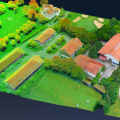
An image from the Kombolgie airborne electromagnetic survey showing a coherent conductivity feature to two kilometres below the surface. Geoscience Australia photo.
Newly acquired data from an Airborne Electromagnetic (AEM) survey has revealed geological features to depths below the Earth’s surface well beyond any previously recorded by airborne systems.
The Versatile Time Domain Electromagnetics (VTEMTM) system operated by Geotech penetrated to depths approaching two kilometres which allows detailed identification of particular features and major structures at depths greater than has been mapped previously using AEM methods.
The data was acquired by Geoscience Australia in the Pine Creek region of the Northern Territory as part of its Onshore Energy Security Program to obtain pre-competitive data in areas which are considered to have potential for uranium or thorium mineralisation.
Prior to the enhancement of the VTEMTM dataset, AEM systems used throughout the world had been able to achieve imaging to a maximum depth of about 800 metres.
An enhanced set of conductivity estimates for the Kombolgie region within the Pine Creek survey area are available as a free download.







